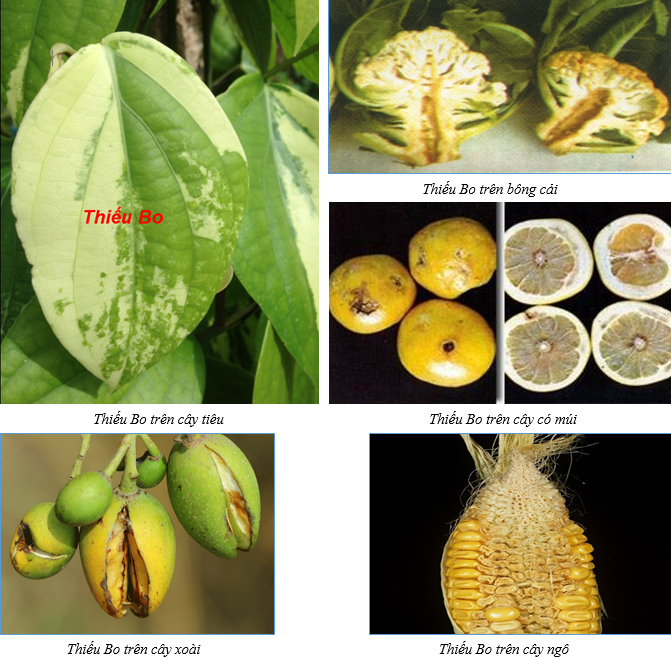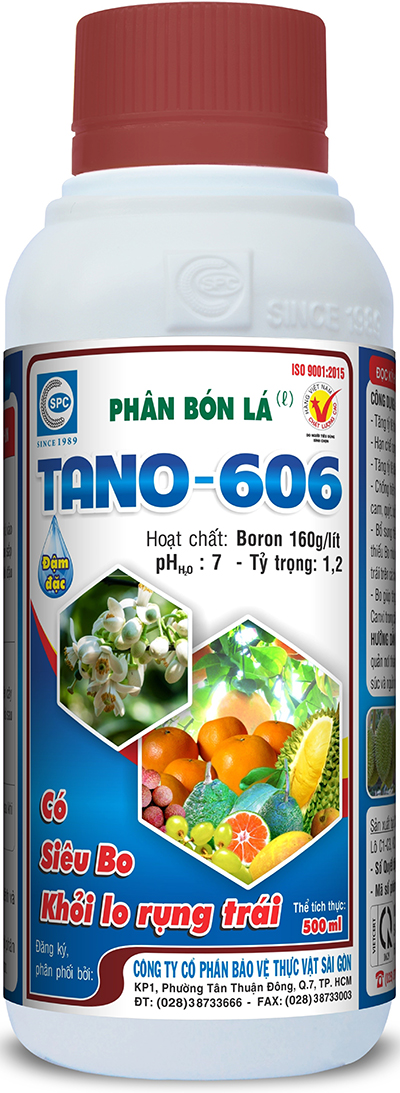|
Tano 606 application in prevention and recovery symptoms of bo deficiency in plant
22/01/2022
Ph.D. Nguyen Van Hong - BSc. Do Cong Hoang As early as 1923, researchers identified Bo (B) as one of the essential trace elements for plants. Today Bo deficiency has been detected in most crops around the world. This article is intended to help gardeners understand in general the role and impact factors of the environment as well as recognize the symptoms and harms when plants lack Bo, how to use TANO 606 product to prevent and overcome the shortage of Bo for plants. 1. Bo is function in plants Bo plays a key role in many processes and functions in the tree such as: - The process of cell division, participate in the formation and stabilization of the cell wall. - Preserve structural and functional integrity of cell membranes. -Transport the products of photosynthesis or energy to the growing parts of the plant. - Bo affects the absorption and utilization of calcium by plants, helping to regulate the ratio of K/Ca in plants. - Increase the vitality of pollen grains, increase pollination rate, increase fruit setting and reduce young fruit drop. - Bo increases the percentage of firm seeds on the panicle and reduces seed drop at harvest. - Especially for legumes, Bo is essential for effective nodulation and nitrogen fixation. 2. Environmental factors affecting Bo deficiency in plants: - Bo mainly moves in the woody veins, following the water from the roots to the stem leading to mature leaves due to the effect of evapotranspiration. Therefore, factors that reduce evapotranspiration such as high air humidity, low soil moisture (dry) will reduce the uptake and transport of Bo in plants. - In addition, prolonged drought and lack of water make the roots less developed, making Bo inaccessible to the roots, making it difficult for plants to absorb. Cold soil also reduces the ability to absorb Bo. - Bo is an element that is easily washed away, so in areas with hot and humid climates, with a lot of rain like Vietnam, there is often a shortage of Bo. Bo deficiency is more likely to occur in acidic soils, soils with coarse texture, soils with low organic matter content. 3. The extent of harm caused by Bo deficiency Bo is a less mobile element, so symptoms of Bo deficiency often begin to appear in the young parts of the plant. Initially the growth apex falters, gradually withering away. The young leaves are often deformed, corrugated and thin with a pale green to discolored color. - Severe Bo deficiency often reduces the length of the roots, the root system is stunted, the root tips are often necrotized. The tree does not flower, the seeds are unfilled, fruit is anchored, there are many cracks on the stem and fruit stalk. The growing apex is dead, and the plant grows more lateral shoots like a shrub. - Low level of Bo deficiency, although not evident on leaves, but also adversely affects pollination and fruit setting. Because the lack of Bo will make flowers less developed, the vitality of pollen grain is weak, the rate of fruit setting is low, young fruit is easy to fall. 4. Some common symptoms of Bo deficiency in crops are as follows: - Rice: Reduces plant height, leaf tips become white and coiled, can kill growth apexes, small panicles, number of tillers and number of seeds per panicle are small. - Mango: The rate of fruit setting is low, young fruit falls a lot, large fruit is often cracked. - Citrus plants: There are scattered yellow spots on the leaves. On the fruit appear brown spots, black spots around the core, eccentric, sour juice. - Grapes: Make small and few fruits. - Root crops: "Brown heart" disease occurs characterized by dark spots or cracks. - Cauliflower: The core is hollow and black, the flowers and stalks are rotten, the leaves fall a lot. - Maize (maize): Low plant, low tasselling ability, small fruit, large core, small and few seeds. - Coffee: Young leaves are deformed, branches are bare, young shoots are withered, young fruit is dropped. - Pepper: Leaves have white streaks, get discolored (Some pictures of crops lack Bo)
5. Measures to prevent and overcome the symptoms of Bo deficiency in crops. Due to the fact that the element bo is less mobile, fertilizing the soil often has low efficiency. Bo deficiency symptoms usually appear in the young parts of the plant such as the growth apexes, young leaves, flowers and fruits. Foliar fertilizer TANO 606 contains a high content of easily digestible Bo, gardeners applying direct spray on leaves and young fruit will quickly overcome and prevent Bo deficiency, contributing to a significant increase in crop yield. Note: fellow farmers need to carefully read the instructions on the product label before use.
|
To prevent, in addition to plowing and burying weed seeds, collecting weed stalks and stumps left after tilling the land to burn, not letting weeds produce seeds in production fields, etc., the use of chemical products is still a measure. optimal because of its ability to thoroughly kill weeds, reduce labor and take advantage of more time than manual weeding.
Miner has the scientific name Phyllocnistis citrella Staint., family Phyllocnistidae, order Lepidoptera. The miner occurs in many countries in the tropics and subtropics. The main host of the miner is the citrus family - Rutaceae. In addition, the miner also attacks mangosteen and some other plants.
Adult is a small planthopper, with a body 2-3 mm long, the whole body is ash gray, slightly greenish, the wings are opaque with many small brown spots.Eggs are oval, 0.3 mm long, have a pointed end and are attached directly to the leaf surface, leaf axils.
Green bugs specialize in the fruit of citrus groups (oranges, tangerines, lemons, grapefruits, kumquats...), some people call them orange bugs, or orange suckers. Their scientific name is Rhynchocoris poseidon or Rhynchocoris humeralis.
In Vietnam, yellow leaf curl disease is very common on papaya trees, especially the disease is often severe in areas of high and continuous planting, areas with hot and arid climates. The disease has significantly reduced the yield and quality of papaya. Gardens that are infected early when the plants are young may not yield. However, up to now, many gardeners still do not know the cause and how to fix it.
Spider mites are common pests on citrus trees, especially in hot and dry climates that are suitable for spiders to grow and cause severe damage.The group of harmful spiders is usually very small in size, unlike the natural enemy spiders.
This group includes species that are generally very small in size, causing damage by sucking plant sap (on leaves, fruits, branches, stems).
There are many species of mealybugs present on the group of Oranges,Tangerines,Grapefruits and Lemons (Citrus), which can be divided into 2 groups:
+ Group of sticky mealybugs with common varieties such as Lepidosaphes, Aonidiella, Coccus and Saissetia.
+ Group of flower mealybugs with common genera and species such as Pseudococcus, Planococcus and Icerya purchasi.
Dry branches and berries disease often appear to be common damage on coffee gardens during the rainy season. The disease causes death of branchs, dry fruit, severely affects the canopy structure and coffee yield if not paid attention to prevention.
Pink disease commonly causes diseases on rubber plantations in the rainy season, especially on garden from 4-8 years old. This year, rubber has to go through a period of severe drought, weakening the tree, so now in tnshe rainy season it is easy to get infected. Therefore, it is necessary to pay attention to good management to avoid affecting the garden.
In recent years, the area of citrus has been expanded because it is a fruit tree with high economic efficiency. However, in order to sell at a high price, not only in quality but consumers also require the external beauty of the fruit, so pest management on citrus is a matter of great concern to farmers. The hot season is a favorable condition for thrips to develop and cause damage, affecting the commercial value of fruit.
- Headquarters
- SAIGON PLANT PROTECTION JOINT STOCK COMPANY
- RQ 1, Nguyen Van Quy St., Tan Thuan Ward, HCM City
- Tax code: 0300632232
- Tel: (028) 38 733 295 - 38 732 077
- Fax: (028) 38 733 003 - 38 733 391
- Website: www.spchcmc.vn - Email: info@spchcmc.vn
- SAIGON PLANT PROTECTION COMPANY
- SAIGON PLANT PROTECTION JOINT STOCK ENTERPRISE
- Lot C1-C3 Hiep Phuoc Industrial Park, Hiep Phuoc Commune, HCM City
- Tel: (028) 3873 4089 - Fax: (028) 3873 4086
- Affiliated Unit
-
- Quick Links
- Home
- About us
- Career Opportunities













